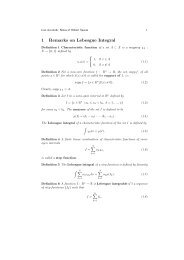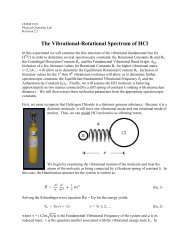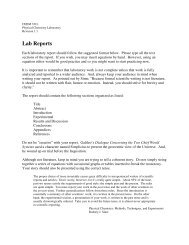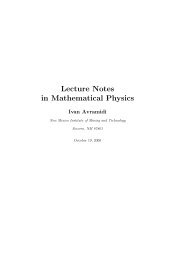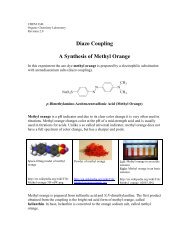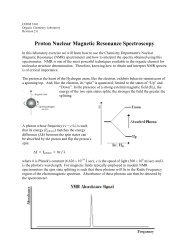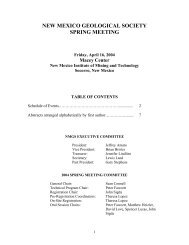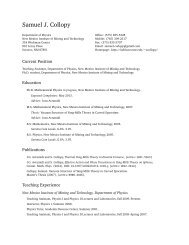A Magnetic α Ï Dynamo in Active Galactic Nuclei Disks - NMT Physics
A Magnetic α Ï Dynamo in Active Galactic Nuclei Disks - NMT Physics
A Magnetic α Ï Dynamo in Active Galactic Nuclei Disks - NMT Physics
You also want an ePaper? Increase the reach of your titles
YUMPU automatically turns print PDFs into web optimized ePapers that Google loves.
– 17 –lead<strong>in</strong>g to the broad emission l<strong>in</strong>es from the <strong>in</strong>terpretation of allowed and forbidden transitionsgive a density of ρ BL ∼ 10 −11 to 10 −13 g/cm 3 , (Sulentic, Marziani & Dultz<strong>in</strong>-Hacyan 2000). Thegeometrical thickness of the disk H <strong>in</strong> radiative pressure dom<strong>in</strong>ated <strong>in</strong>ner zone is <strong>in</strong>dependent ofthe disk model and the mechanism of angular momentum transport and is given by equation (A5).In thermal pressure dom<strong>in</strong>ated part of the disk, H weakly depends on Σ as H ∝ Σ 1/8 . Only <strong>in</strong>the case of the RVI disk does the low thickness, Σ RV I ∼ 10 2 to 10 3 g/cm 3 , lead to a sufficiently lowdensity, ρ RV I = Σ RV I /H ≃ Σ RV I ·3·10 −14 g/cm 3 , which is consistent with the above estimates forthe density of the star-disk driven matter emitt<strong>in</strong>g the broad emission l<strong>in</strong>es. On the other hand,the Shakura–Sunyaev disk would be expected to have a density ρ SS given by expression (A6) <strong>in</strong>the radiation dom<strong>in</strong>ated zone (a) and expression (A25) <strong>in</strong> the pressure dom<strong>in</strong>ated zone (b). If oneequates the observed width of broad emission l<strong>in</strong>es (∼ 7·10 3 km/s) to the Doppler shift at Keplerianvelocity, one obta<strong>in</strong>s an estimate of the location of the broad l<strong>in</strong>es region at r ∼ 10 3 r g . This radiusfalls not far from the boundary between zones (a) and (b) <strong>in</strong> the Shakura–Sunyaev disk model(see expression (A2)). The density of the Shakura–Sunyaev disk at this radius is ∼ 10 −6 g/cm 3 to10 −8 g/cm 3 depend<strong>in</strong>g upon the parameters of the model. This is at least 5 orders of magnitudelarger than ρ BL required by observations. The differences <strong>in</strong> ρ for Shakura–Sunyaev and RVI disksare almost completely attributable to the much lower column thickness Σ RV I than Σ for Shakura–Sunyaev model. Regardless, the function of the plumes for produc<strong>in</strong>g the helicity for the dynamoshould be <strong>in</strong>dependent of these differences <strong>in</strong> the models of the disk.Star disk collisions were first suggested as the source of the BLRs by Zurek, Siemig<strong>in</strong>owska, & Colgate(1994), Zurek, Siemig<strong>in</strong>owska, & Colgate (1996), but a detailed calculation of the phenomena hasnot yet been performed, because it requires 3-D hydrodynamics with radiation flow and opacities determ<strong>in</strong>edby multiple l<strong>in</strong>es. An approximation to this problem was calculated by Armitage, Zurek & Davies(1996) for the purpose of determ<strong>in</strong><strong>in</strong>g the mass accretion rate of giant stars by dynamic frictionwith the disk, but the radiation flow <strong>in</strong> th<strong>in</strong> disks was not considered. We recognize that verymany additional variables of hydrodynamics, radiation, and geometry must be taken <strong>in</strong>to account<strong>in</strong> order to positively identify BLRs with star disk collisions. With these caveats we proceed toanalyze the star collisions with the disk and the result<strong>in</strong>g plume formation from the standpo<strong>in</strong>t ofthe fluid dynamics that has consequences for the dynamo.4. Plumes Produced by Star Passages through the DiskThe first result of a star-disk collision is to cause a local fraction of the mass of the disk to riseabove the surface of the disk because of the heat generated by the collision. Two plumes expand<strong>in</strong>gon both sides of the accretion disk will be formed. A second result is the expansion of this ris<strong>in</strong>g massfraction relative to its vertical axis <strong>in</strong> the relative vacuum above the disk surface and aga<strong>in</strong> becauseof the <strong>in</strong>ternal heat generated by the collision. A third result is the rotation (anticyclonic) of thisexpand<strong>in</strong>g matter relative to the Keplerian frame corotat<strong>in</strong>g with the disk because of the Coriolisforce act<strong>in</strong>g on the expand<strong>in</strong>g matter. Aga<strong>in</strong> we emphasize that this rotation through a f<strong>in</strong>ite angle




